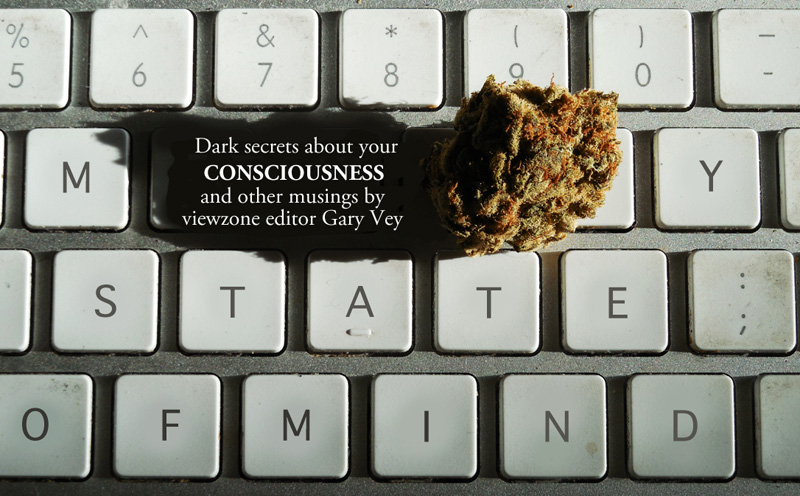
"The king's ka is, of course, the ka of a god, operates as his messenger, to himself is the voice of his ancestors, and to his underlings is the voice they hear telling them what to do." -- Julian Jaynes
I hope you are all still with me. I didn't want to get bogged down in the historical evidence. If you have read this far then you obviously have the interest and intellect to do your own searching. I am only touching on the most obvious civilizations such as Sumer and Egypt. The ancient Chinese and Central American cultures are also a rich source of evidence. But right now, let's look at ancient Egypt.
The Egyptian empire spans many millennia. I'm going to focus on the New Kingdom (1556 to 1070 BCE), since this is the time that the evolution of consciousness takes place. This period covers the 18th, 19th and 20th dynasties.
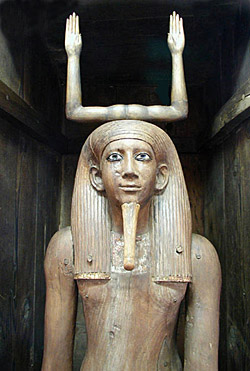 The Egyptians invented a similar writing system to the Sumerians. Small pictures represented the actual object being referenced. These pictures were likewise abbreviated to simple symbols. But then the Egyptians did something different. They used these symbols to represent sounds (phonetics) which allowed the writing to closely follow the spoken language. It also increased the Egyptian vocabulary since one could now "spell" new words easily.
The Egyptians invented a similar writing system to the Sumerians. Small pictures represented the actual object being referenced. These pictures were likewise abbreviated to simple symbols. But then the Egyptians did something different. They used these symbols to represent sounds (phonetics) which allowed the writing to closely follow the spoken language. It also increased the Egyptian vocabulary since one could now "spell" new words easily.
This flexibility in Egyptian vocabulary allowed them to explore abstract ideas and concepts, including their own minds. Egyptians had a kind of psychology which described their bicameral experience.
The image on the right is of a king from an earlier (13th) dynasty. I show it here because it best illustrates the concept of the ka, which, as I will attempt to show you, is the representation for the bicameral voice, a person's volition.
Along with the ka is the ba. These two elements of mind and soul were at the heart of the elaborate death rituals, mummification and monument building of the Egyptians rulers. So when these began to change -- as bicameral voices surrendered to the inner voice of consciousness -- the entire civilization was threatened.
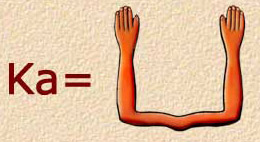 The Ka:
The Ka:"The ka was a person's double," is the standard interpretation for this aspect of bicameral man's inner life. The ka was given to man at birth but was not part of man and his personality. It was not from man but something special that guided him and which he always obeyed. The ka was man's volition, his will, and it was synonymous to the hallucinated voice of authority that guided men and kings. The symbol of the ka was two upraised arms with hands extended. This is the symbol of submission as the ka is ALWAYS obeyed. In some texts it states that, "the king (pharaoh) makes a man's ka." For it is the voice (ka) of the ruler that directs the will of man. Frequently the word pops up in the names of high officials such as Kaininesut ("my ka belongs to the king") or Kainesut ("the king is my ka"). In the Cairo Museum, stella number 20538 says, "the king gives his servants Ka's and feeds those who are faithful." 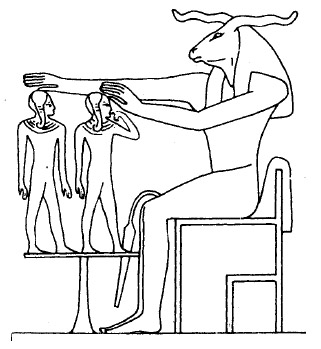 Above The creation of man on a potters wheel. The god Khum forming the future king with his right hand and the king's ka with the left on the potters wheel. Note that the ka points with its left hand (controlled by the Right Hemisphere) to its mouth, indicating its Right Hemisphere's bicameral verbal function. [On a monument of Amenhotep III (1405 - 1370 BC.) at Luxor. 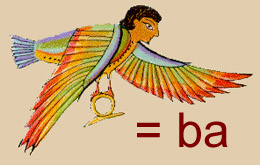 The Ba:
The Ba:The ba was the non-physical essence of the person. It was the result, over a lifetime, of integrating the guidance of the ka into one's personality. If you think of the ka as providing a kind of direction, instruction or recipe of life, then the ba is the result of how well one followed that direction... the bread of one's life. The ba was seen as a human-headed bird hovering over the deceased or exiting the tomb in the hieroglyphics, and was the part of the soul that could travel between the worlds of the living and the dead. During the Age of the Pyramids, it was believed only the King had a ba. In later periods of New Kingdom, it was believed every person had a ba.
|
Sure, there are other aspects of Egyptian psychology of a spiritual nature, but the ka and ba are the most relevant to our search for consciousness. I cannot stress the importance of the king's ka because he heard the hallucinated voice of previous (deceased) kings as well as that of Osiris, the god of gods. This was the king's claim to being divine.
The idea of the king, pharaoh or priest being in contact with deceased rulers or gods is something that one can find happening all over the globe at this time. Unlike the third millennium BCE, when life was full of growth and prosperity, things started to break down during the second millennium. The god voice first grew silent in the minds of ordinary people. But eventually even the kings heard silence.
With writing, the pronouncements of the bicameral voice from priests or kings were written down and shared. The need to contact the bicameral voice became less frequent. Texts of past guidance or warnings were used as the first written laws. As these laws and pronouncements were read by people, the words began to form an inner voice that would eventually become the narrative of our consciousness.
|
King Akhenaten And Monotheism
Akhenaten apparently realized the gradual impotency of the many different bicameral voices. There were gods for victory at war, for a healthy childbirth, for protection against floods or pests -- gods for everything. So this 18th dynasty pharaoh attempted to ban the worship of all gods except one, Aten, who was symbolized by the solar disc. This was perhaps made more urgent following the incident where a plague devastated the country and Akhenaten's father, Amenhotep III, claimed the god Amen commanded the sacrifice of all first born children. When the plague persisted, despite the sacrifices, there was concern that the god's voice was in error. Lucky for Akhenaten, the first born, he was not sacrificed. He soon turned to another god, Aten, and rejected all the other god voices. This, of course, did not sit well with the many priests and institutions who were founded on the worship and interpretation of the commands of the many diverse gods. There was much tension with this new experiment and it did not last. After just seventeen years of his reign, Akhenaten apparently died from injuries he suffered in an accident and his memory was quickly wiped clean from Egyptian history.
Right: Akhenaten shown worshiping Aten, represented by the sun disc and rays.
|
Personally, I think consciousness began to develop earlier than 1000 BCE. I could be wrong but I think it happened with some people, not all, hundreds of years earlier. If Akhenaten exhibited this new way of thinking in 1336, it might also show up again later in Egyptian history. And it does.
As early as 1150 BCE, there is evidence of consciousness. This is suggested by a rare manuscript that was recently found, hidden away in an Egyptian museum. Called the "erotic" Turin Papyrus (below), if we are interpreting the art correctly, it shows evidence of imagination, humor and perhaps even lust.
|
First Evidence of Consciousness -- porn
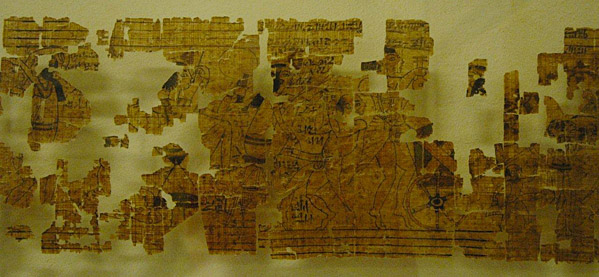
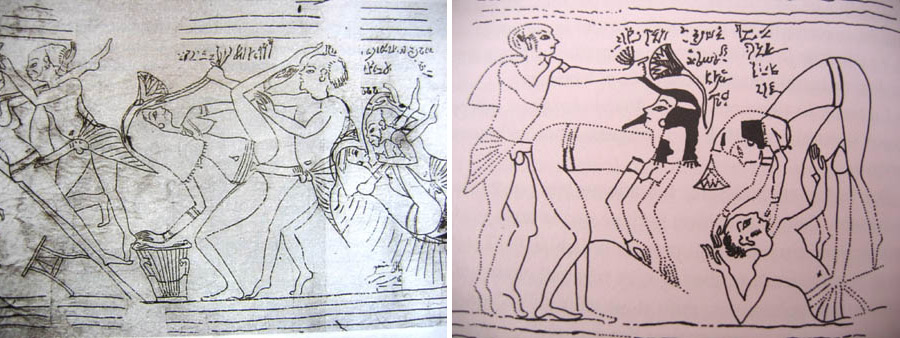 The Turin Papyrus was drawn around 1150 BCE and was hidden away because of its sexual content. It was thought to be drawn by one of the scribes for either his personal reasons or as the world's first "men's magazine". The scribbled text in the margins translates loosely as: "... come behind me with your love, Oh! Sun, you have found out my heart, it is agreeable work..." Jaynes warns us that as we look at evidence from the bicameral times we need to be careful not to assume that men thought the same as we do now. Without a personal "self" the act of sex, death and life itself becomes different. Bicameral man was a "thing" in the same way that he acknowledged other things. There was no sense of shame, humor or even love without a "self" to participate in these emotions.
I also noticed that the women in the art are depicted with a blue lotus flower over their heads. This signifies that they were using the Blue Lotus as a kind of intoxicant, for which it is known today. The use of psychedelics and psychotropics in bicameral times is a whole other story that adds to the development of consciousness and that will hopefully come later in this story.
|
All this talk about psychotropics has me looking for my pipe. Before I go, next up I will zero in on the Biblical accounts of bicameral man and an attempt to hack the voice. (later)
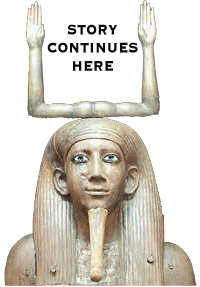
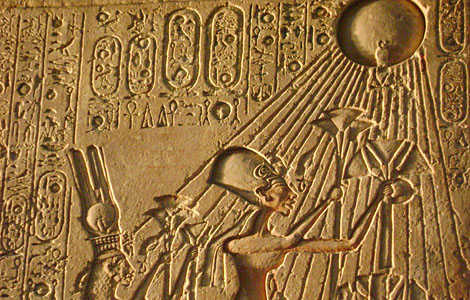 One of the most controversial kings in the New Kingdom (1336 to 1334 BCE) was Akhenaten, whose name means living spirit of Aten. This presumably meant that he was a conduit for the voice or ka of the god, Aten. I have come to the conclusion that Akhenaten must have attained consciousness because he acted as an individual, promoting an idea that was contrary to the historic traditions of the bicameral voice.
One of the most controversial kings in the New Kingdom (1336 to 1334 BCE) was Akhenaten, whose name means living spirit of Aten. This presumably meant that he was a conduit for the voice or ka of the god, Aten. I have come to the conclusion that Akhenaten must have attained consciousness because he acted as an individual, promoting an idea that was contrary to the historic traditions of the bicameral voice. So, although 1150 BCE seems a bit early, I suspect that those intimately involved with writing -- like the scribe who composed the papyrus -- might have developed consciousness first.
So, although 1150 BCE seems a bit early, I suspect that those intimately involved with writing -- like the scribe who composed the papyrus -- might have developed consciousness first.